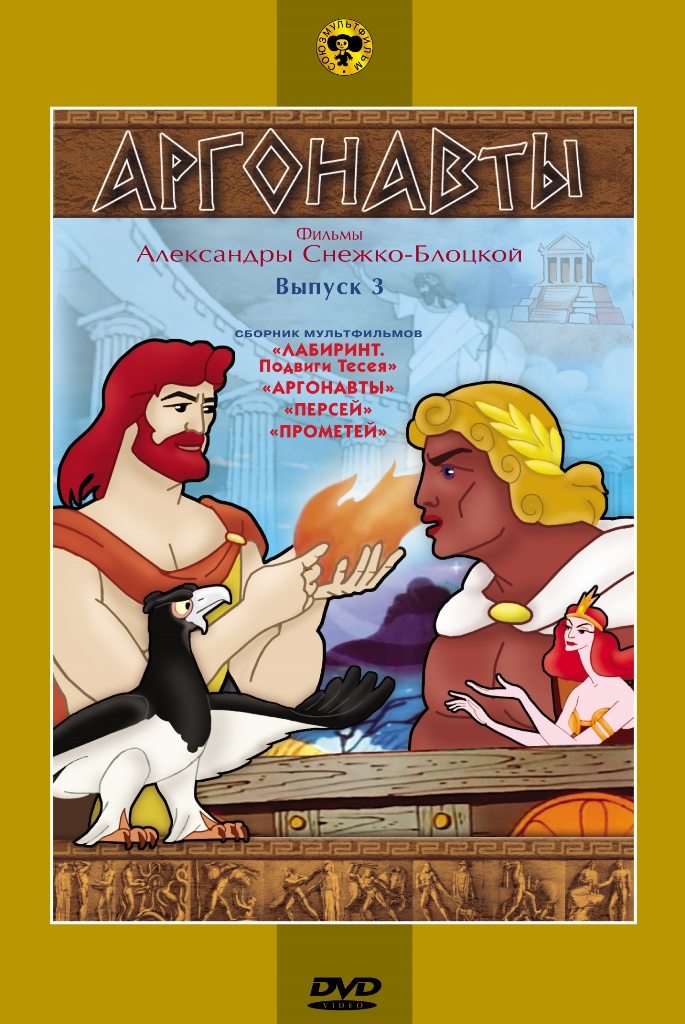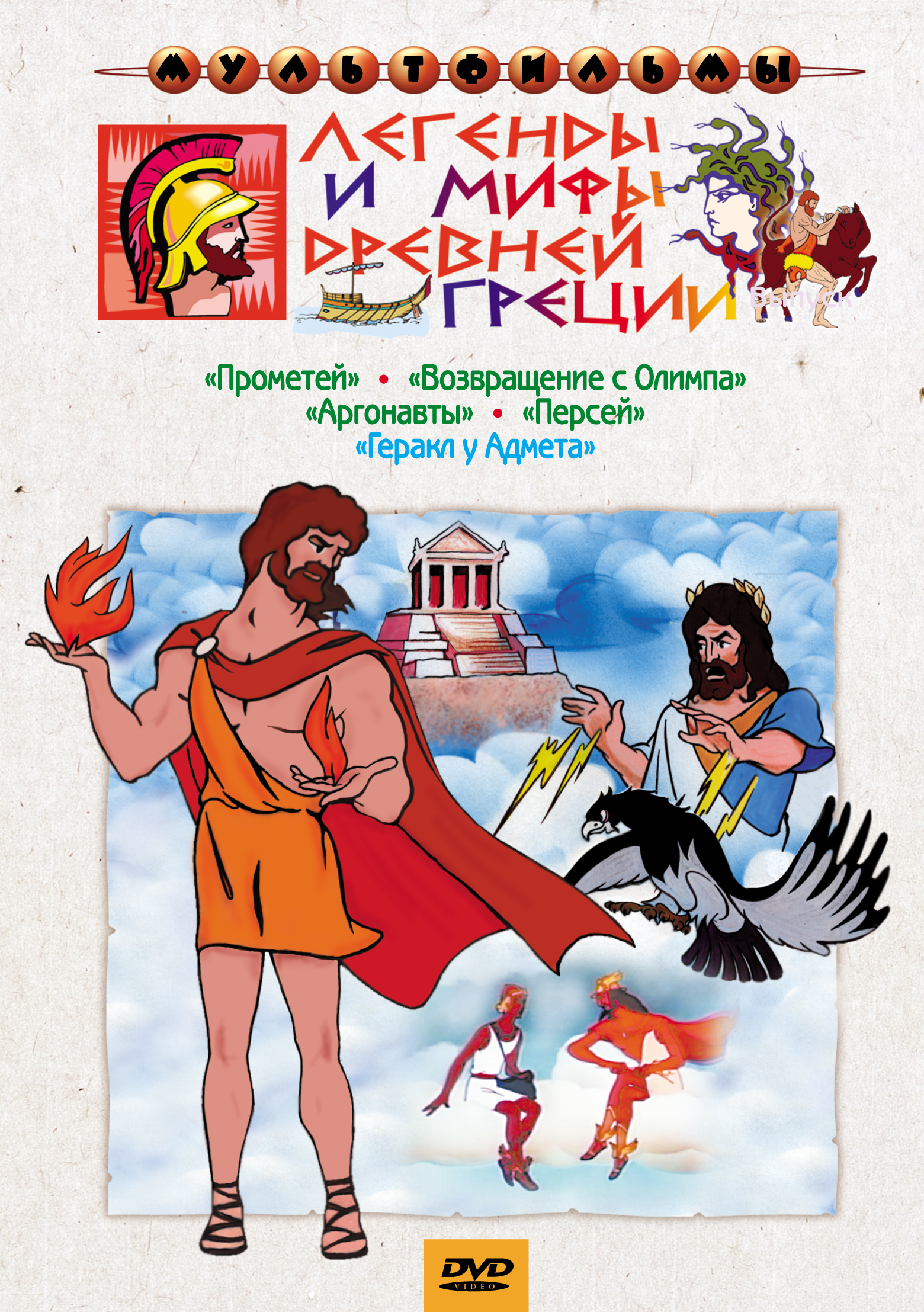Title of the work
Studio / Production Company
Country of the First Edition
Country/countries of popularity
Original Language
First Edition Date
First Edition Details
Прометей [Prometheus (Prometeĭ)]. Directed by Aleksandra Snezhko-Blotskaia, script by Aleksei Simukov. Legends and Myths of Ancient Greece 5. Moscow: Soyuzmultfilm, 1974.
Running time
Format
Date of the First DVD or VHS
Available Onllne
The movie is available on the “Soyuzmultfilm” youtube channel (accessed: August 17, 2018).
Genre
Animated films
Hand-drawn animation (traditional animation)*
Myths
Short films
Target Audience
Children (6+)
Cover


The covers of the entire series Legends and Myths of Ancient Greece. Courtesy of the Film Video Association Крупный план” [Close-up (Krupnyĭ plan)] close-up.ru, accessed: August 17, 2018.
Author of the Entry:
Hanna Paulouskaya, University of Warsaw, hannapa@al.uw.edu.pl
Peer-reviewer of the Entry:
Elżbieta Olechowska, University of Warsaw, elzbieta.olechowska@gmail.com
Lisa Maurice, Bar-Ilan University, lisa.maurice@biu.ac.il

Aleksei Simukov
, 1904 - 1995
(Screenwriter, Scriptwriter)
Aleksei Simukov was born in St Petersburg, in a family belonging to the intelligentsia. He received classical education at the Third Classical Gymnasium (the only one in St Petersburg where Greek and Latin was taught at the time). In 1925 Aleksei Simukov moved to Moscow. He studied at the art studio of Ilya Mashkov at the Association of the Artists of Revolutionary Russia (AKhRR) and also at the Maxim Gorky Literature Institute.
He began writing plays for theatre and cinema, including animation. He preferred comical and lyrical genres, following the tradition of the 19th-century Russian theatre.
Aleksei Simukov was a lecturer at the Maxim Gorky Literature Institute. He was a literary editor of the Soyuzmultfilm studio (1944–1946), worked at the Ministry of cinematography of the USSR (1947–1950), later at the Union of Soviet Writers (1950s), and still later at the Theatre Department of the Ministry of Culture of the USSR (1964–1971) having influence on the repertory of the theaters in the country.
In his memoirs Simukov writes about scripts for the movies of Aleksandra Snezhko-Blotskaia about the Greek mythology. He says that at that time he became fascinated by myths. They inspired him to continue developing this theme and he also wrote two plays about the Greek mythology. These were Гори, гори ясно (Burn, Burn, Brightly) about Heracles and Prometheus, and Взгляд Медузы (A Glance of Medusa) about Perseus.
His life spanned pre-revolutionary and post-Soviet Russia; he finished his memoirs in 1994, a year before he died.
Source:
Simukov, Aleksei, Чертов мост, или Моя жизнь как пылинка Истории [A Devil's Bridge or My Life as a Speck of History], Moskva: Agraf, 2008.
Bio prepared by Hanna Paulouskaya, University of Warsaw, hannapa@al.uw.edu.pl

Aleksandra Snezhko-Blotskaia
, 1909 - 1980
(Director)
Aleksandra Snezhko-Blotskaia was a Russian animator and movie director.
Born in Vovchansk in Kharkiv Oblast (today in Ukraine), she later moved to Moscow oblast and Moscow. In 1925–26 she studied at the Fëdor Rerberg Art School. In 1926 she joined an art studio at the Association of the Artists of Revolutionary Russia (AKhRR). She also studied at the Architecture and Construction Institute.
From 1934 she worked at animation. First, at the Союзкинотехника ([Soviet] Union Cinema Techniques), then at the Experimental Cartoon Studio directed by Victor Fëdorovich Smirnov, at the Межрабпомфильм (Movies for Workers International Relief). She started as animator, then for a long time worked as assistant-director for Ivan Ivanov-Vano. From 1956 she worked independently and produced film adaptations of fairy tales of different nations: Verlioka (a Russian folktale, 1957), Янтарный замок ([An Amber Castle], a Lithuanian folktale, 1959), Дракон ([A Dragon], a Burmese folktale, 1960–61), Чудесный сад ([A Miraculous Garden], a Kazakh folktale, 1962), Дочь солнца ([The Sun’s Daughter], a Chukchi folktale, 1964).
She also adapted Rikki-Tikki-Tavi (1965) and The Cat that Walked by Himself (1968) by Rudyard Kipling as well as Сказка о золотом петушке ([The Tale of the Golden Cockerel], 1967) by Alexander Pushkin.
In 1969–74 she produced a series of movies about Greek mythology commissioned by the Ministry of Education of the USSR: Возвращение с Олимпа (The Return from Olympus, 1969), Лабиринт – подвиги Тесея (Labyrinth, the Deeds of Theseus, 1970–71), Argonauts (1972), Perseus (1973), Prometheus (1974). It was the most important series of animated movies about Greek mythology ever made in the USSR. The Return from Olympus was the first movie in the series Legends and Myths of Ancient Greece.
Source:
Bogdanova, Siuzanna, “Очерки и жизни и творчестве Александры Гавриловны Снежко-Блоцкой” [Essays on the Life and Work of Aleksandra Gavrilovna Snezhko-Blotskaia], Кинограф 19 (2008): 207–240.
Bio prepared by Hanna Paulouskaya, University of Warsaw, hannapa@al.uw.edu.pl
Summary
On Mount Olympus there is a divine fire guarded by an Eagle. Hephaestus invents a machine with four hands to guard the fire. Caring for mortals on Earth, Prometheus steals the fire and gives it to them. Human beings are transformed into civilized Greeks thanks to this gift.
Zeus sends the Eagle and Hephaestus to extinguish the fire on Earth and to punish Prometheus. Due to the flood sent by Zeus, the fire is almost completely out. Prometheus gives the last spark to a human family he meets. People are saved, but Prometheus loses his power and is chained by Hephaestus; he is then tortured by the Eagle, who like a KGB or police officer demands answers about Prometheus’ motivation in helping mortals. When Prometheus truthfully replies that helping people was his goal, the Eagle laughs and doesn’t believe him. Mortals manage to keep the fire in defiance of Zeus.
Analysis
This is the last movie from the series “Legends and Myths of Ancient Greece” which entirety merits to be included in the database. This movie is especially interesting because of its topic. The character of Prometheus was a key figure for the Soviet culture. He was a hero who fought against the gods in order to help mortals, who valued them more than himself, who was tortured and suffered for his good deeds. The fire he brought to Earth usually was interpreted as the fire of knowledge (“Prometheus” was a frequent name for bookstores in the USSR). These ideas – fight with gods (or atheism), revolution, humanism, self-denial, patience, enlightenment – were of crucial importance for the Soviet ideology.
In the movie Prometheus explains why he brought the fire to people as follows: “When people will get the divine fire, they will become like us, gods.” So he fights for equal rights for all, like a believer in Communist International who longs for the coming of world communism.
Prometheus also teaches people skills, for example how to work with stone. He clearly advocates for the working class.
Another important character of the movie is Hephaestus, which resembles the character depicted by Aeschylus (Prom. 12–88). He is a skillful inventor able to fabricate a robot. He looks like an artisan and he is also a true member of working class. Though he does not care about people, he cares about his friend Prometheus. When he is sent to punish him, Hephaestus has moral issues: he doesn’t want to harm Prometheus, but is accompanied by the Eagle and cannot avoid his task. The topic of helping a friend (often in the form of sacrificing one’s life for a friend) was central for the Soviet cinema about World War II. Though Hephaestus doesn’t oppose Zeus and he is not a revolutionary hero, he tries to stay loyal to his friend and reveals moral issues, torn between the authority and the friend.
The Eagle is the same one as in the first movie of the series (The Return from Olympus). He acts in the name of Zeus and plays the role of jailer and inquisitor at the end of the movie.
Further Reading
Bogdanova, Siuzanna [Богданова, Сюзанна], “Очерки о жизни и творчестве Александры Гавриловны Снежко-Блоцкой” [Essays on the Life and Work of Aleksandra Gavrilovna Snezhko-Blotskaia (Ocherki o zhizni i tvorchestve Aleksandry Gavrilovny Snezhko-Blotskoĭ)], Kinograf 19 (2008): 207–240.
Simukov, Aleksei [Симуков, Алексей], Чертов мост, или Моя жизнь как пылинка истории [The Devil's Bridge or My Life as a Speck of History (Chёrtov most, ili Moia zhizn' kak pylinka istorii)], Moskva: Agraf, 2008.
But, Ekaterina, “Prometheus in Russia: From Revolution to Dissidence,” Classical Receptions Journal 14.4(2002): 533–553. https://doi.org/10.1093/crj/clac015
Profile at animator.ru (accessed: August 17, 2018).
Profile at imdb.com (accessed: August 17, 2018).
Profile at kinopoisk.ru (accessed: August 17, 2018).
Addenda
The Remaining Production Credits:
Music by Vitaly Geviksman (1924–2007); Cinematography by Boris Kotov (1922–1984); Art direction by Aleksandr Trusov (1912–1988); Sound director Boris Filchikov;
Animators: Nikolai Fëdorov; V. Kolesnikova; V. Kushnerev; O. Orlova; O. Safronov; Viktor Shevkov; V. Shevchenko.
Date of the First VHS and DVD Edition:
According to Wikipedia, the movie was released in the 1980s on VHS in the series “Видеопрограмма Госкино СССР” [Video program of the State Committee for Cinematography of the USSR (Videoprogramma Goskino SSSR)]. I was unable to confirm this information.
The movie was released on DVD in 2005 by Film Video Association “Крупный план” [Close-up (Krupnyĭ plan)] in a collection of movies called Легенды и мифы Древней Греции [Legends and Myths of the Ancient Greece (Legendy i mify Drevneĭ Gretsii)]. The DVD also contained the movies Возвращение с Олимпа [Return from Olympus(Vozvrashcheniie s Olimpa)], Аргонавты [The Argonauts(Argonavty)] and Персей [Perseus (Perseĭ)] by Aleksandra Snezhko-Blotskaia and Геракл у Адмета [Hercules at the Court of Admetus (Gerakl u Admeta)] by Anatoly Petrov.
It is also part of a collection of movies called Аргонавты. Фильмы А. Снежко-Блоцкой, вып. 3 [The Argonauts. Movies by A. Snezhko-Blotskaia, Disc 3 (Argonavty. Filmy A. Sniezhko-Blotskoĭ, vyp. 3)] released by the same company in 2009. The DVD contained also movies Аргонавты [The Argonauts(Argonavty)], Лабиринт. Подвиги Тесея [Labyrinth. The Deeds of Theseus (Labirint. Podvigi Teseia)], Персей [Perseus(Perseĭ)].
There were other releases of the DVDs after 2009.
All links accessed: August 17, 2018.


